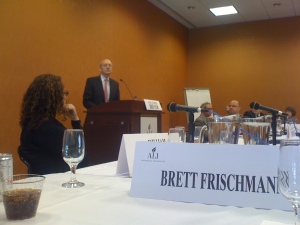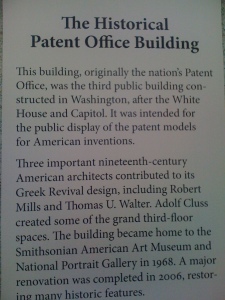Tags: american law institute, copyright, dcma, georgetown law school, patent, stephen breyer
trackback

Justice Breyer?s Lunch Talk
I?ve just participated in a small conference on copyright and patent law, hosted by the American Law Institute and Georgetown University Law Center, a few steps from Capitol Hill in Washington, DC. Of the 40 people in the room, I was the only one who was not a lawyer or a legal scholar?I was invited to contribute perspectives from creativity research. I was honored to be in the room, because these were some of the most highly respected people working in intellectual property?scholars from Stanford and NYU; senior legal counsel from Google and Walt Disney; judges on the Federal Circuit Court; and our lunch speaker, Supreme Court Justice Stephen Breyer. He impressed the hell out of me?a great speaker, savvy in the political ways of Washington, and a brilliant mind. The smartest guy in the room?and in this room, that was saying a lot.
Although a lot of the legal terminology went over my head??doctrine of equivalence? and ?settled expectation??it was really stimulating. After all, the research shows that one of the best ways to stimulate creativity is to learn something about a new field related to your own. I give this advice in my new book, Zig Zag (on pages 67 and 68):
Branch out: Always start with your core area of expertise?but don?t stop there. Branch out and study subjects in every area that is somehow related to your problem?.Successful creators are curious by nature. They ask questions and listen closely to the answers, even when the information has no obvious relationship to what they?re working on at the moment.
This conference was perfect for me, because intellectual property lawyers think about creativity every day, but using a totally different language and perspective from my creativity research colleagues. Here are some of the key themes I took from the day:
- The panel I spoke on discussed how (and whether) patents and copyrights provide incentives to creators to create. The research shows, not very much. Creators almost never think about patents or copyrights; when they do, they mostly get annoyed and consider them to be a hassle. Lots of creativity takes place in areas which are not eligible for patents or copyrights?from top chefs inventing new recipes, to the time-consuming and effortful work of writing fan fiction.
- Do judges even need to pay attention to what these scholars think patents and copyrights should do? After all, isn?t the role of a judge simply to interpret the statutes as written by Congress? I was a bit surprised to discover that pretty much everyone in the room thinks this is na?ve and simplistic. The statutes are thought to be broad and ambiguous, open to interpretation. And after ten or twenty years, things change so much?and so much case law develops?that the statute really isn?t that helpful any more.
- Justice Breyer was asked, ?We have a bumper crop of IP cases before the Supreme Court; is there an increased interest in these issues?? Breyer?s response was that the legal community has been saying that the Federal Circuit Court (which handles all patent appeals for the entire U.S.) has become ?too patent friendly,? and the Supreme Court is listening and essentially, checking to see if that?s true.
- A common theme was the tension between generality and specificity. Patent law is general?it applies to all technologies and scientific domains. One could imagine a more specific regime; for example, the Digital Millenium Copyright Act (DCMA) is a statute concerning intellectual property that is specific (to digital rights and copyrights) rather than general. My sense was that the consensus was in favor of general regime and against specific regimes. A second manifestation of this tension is with the courts; the Federal Circuit Court handles all patent appeals, which means those judges develop specialized knowledge about patents. Before the Federal Circuit was created, patent appeals were heard in the regional District Courts, by judges who heard appeals of every kind of decision?a more general role. Most scholars seem to think this is a good idea, although the Federal Circuit has been widely criticized, as Justice Breyer noted, for being too patent friendly.
The stated theme of the conference was ?bringing together copyright and patent law in court,? and I?m not sure we got any good answers for how to do that. But I probably only think that because I?m not part of this legal community; the folks I met there told me that copyright experts and patent experts are like people from two different planets, who rarely come together. In the courts, the Federal Circuit handles patents and the District Courts handle copyrights. So I?m pretty sure the conference organizers would consider the event a success, simply by getting copyright people and patent people in the same room together.
 I stayed one extra day, and toured several museums. The high point was visiting the old Patent Office, just a few blocks from the conference, which had a special exhibit of historic patent models from the 19th century. The building also houses the National Portrait Gallery and the Smithsonian Museum of American Art. And?it?s a bit geeky?but I also loved the Postal History Museum, in the old post office building right next to Union Station. If you want to learn about facer-canceller machines, or about the handmade artwork in old cancellation stamps, this is the place for you!
I stayed one extra day, and toured several museums. The high point was visiting the old Patent Office, just a few blocks from the conference, which had a special exhibit of historic patent models from the 19th century. The building also houses the National Portrait Gallery and the Smithsonian Museum of American Art. And?it?s a bit geeky?but I also loved the Postal History Museum, in the old post office building right next to Union Station. If you want to learn about facer-canceller machines, or about the handmade artwork in old cancellation stamps, this is the place for you!
Like this:
Loading...
Source: http://keithsawyer.wordpress.com/2013/02/25/bringing-together-copyright-and-patent-law/
Revolution TV Show bankofamerica revolution rosh hashanah rosh hashanah boardwalk empire iOS 6 Release Date
No comments:
Post a Comment
Note: Only a member of this blog may post a comment.